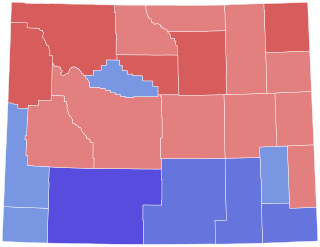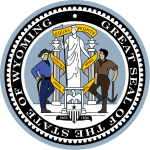
The 1964 United States Senate elections were held on November 3. The 33 seats of Class 1 were contested in regular elections. Special elections were also held to fill vacancies. They coincided with the election of President Lyndon B. Johnson by an overwhelming majority, to a full term. His Democratic Party picked up a net two seats from the Republicans. As of 2023, this was the last time either party has had a two-thirds majority in the Senate, which allowed the Senate Democrats to override a veto, propose constitutional amendments, or convict and expel certain officials without any votes from Senate Republicans. However, internal divisions would have prevented the Democrats from having done so. The Senate election cycle coincided with Democratic gains in the House in the same year.

Joseph Maull Carey was an American lawyer, rancher, judge, and politician, who was active in Wyoming local, state, and federal politics.

The 1960 United States Senate election in Wyoming was held on November 8, 1960. Incumbent Democratic Senator Joseph C. O'Mahoney was first appointed to the U.S. Senate from Wyoming's Class 1 Senate seat in 1934, and was re-elected in 1934, 1940, and 1946 before losing re-election in 1952. He was then elected to the Class 2 Senate seat in 1954. O'Mahoney, in failing health and increasingly limited in his mobility, declined to run for a fifth non-consecutive term in the Senate. The winner of this election, Keith Thomson, died before assuming his elected office.

The 1922 United States Senate election in Wyoming took place on November 7, 1922. First-term Democratic Senator John B. Kendrick ran for re-election to a second term. He was opposed by Republican Congressman Frank W. Mondell, the Majority Leader of the U.S. House of Representatives. Kendrick won re-election by a wide margin, defeating Mondell, despite his long record of representing the state in Congress, with 57% of the vote to Mondell's 43%. Kendrick was also able to increase his margin of victory from 1916, despite Republicans generally doing well in Wyoming in 1922.

The 1940 United States Senate election in Wyoming took place on November 5, 1940. Democratic Senator Joseph C. O'Mahoney ran for re-election to a second full term. He faced Republican Milward Simpson, a member of the University of Wyoming Board of Trustees and a former State Representative, in the general election. Though the presidential election in Wyoming was relatively close, O'Mahoney outperformed President Franklin D. Roosevelt's narrow win, and defeated Simpson in a landslide to win his second term.

The 1978 United States Senate election in Wyoming was held on November 7, 1978. Incumbent Republican Senator Clifford Hansen declined to seek a third term in office. Former State Representative Alan K. Simpson, the son of former Senator Milward Simpson, won a contested Republican primary and faced Raymond B. Whitaker, the 1960 Democratic nominee for the Senate, in the general election. Despite a favorable environment for Republicans nationwide, Simpson's performance decreased considerably from Hansen's 1972 landslide. Nonetheless, he easily defeated Whitaker, winning 62% of the vote to Whitaker's 38%.

The 1918 Wyoming gubernatorial election took place on November 5, 1918. Following the election of Governor John B. Kendrick to the U.S. Senate in 1916, Secretary of State Frank L. Houx served as acting Governor. He ran for re-election and faced a stiff challenge in the Democratic primary from attorney William B. Ross. After defeating Ross by a decisive margin, he faced Robert D. Carey, the Republican nominee and the son of former Democratic Governor Joseph M. Carey. However, despite Houx's past electoral success, he faced difficult headwinds as Democratic candidates did poorly across the country in 1918. He ended up losing re-election to Carey by a wide margin.

The 1954 United States Senate elections in Wyoming took place on November 2, 1954. Incumbent Democratic Senator Lester C. Hunt, who decided not to be a candidate for re-election, committed suicide by firearm on June 19, 1954, and Republican Governor Clifford J. Rogers appointed former state highway commissioner Edward D. Crippa to replace him. Two elections for the Senate seat were held on the same day; one as a special election to fill the remainder of Hunt's original six-year term, and another to select a Senator to serve the next six-year term. Senator Crippa did not run for re-election.

A general election was held in the U.S. state of Wyoming on Tuesday, November 2, 1926. All of the state's executive officers—the Governor, Secretary of State, Auditor, Treasurer, and Superintendent of Public Instruction—were up for election. Republicans narrowly picked up the governorship and solidified their control on the other statewide offices, increasing their margin of victory in each race.

A general election was held in the U.S. state of Wyoming on Tuesday, November 4, 1930. All of the state's executive officers—the Governor, Secretary of State, Auditor, Treasurer, and Superintendent of Public Instruction—were up for election. Republicans narrowly held onto the Governor's office and won every other state office.

A general election was held in the U.S. state of Wyoming on Tuesday, November 5, 1946. All of the state's executive officers—the governor, secretary of state, auditor, treasurer, and superintendent of public instruction—were up for election. The election was largely a rout for the Republican Party. Though Democratic governor Lester C. Hunt was narrowly re-elected, Democrats lost their two other state offices: auditor and secretary of State. Moreover, they were unable to win back any other state offices.

A general election was held in the U.S. state of Wyoming on Tuesday, November 7, 1950. All of the state's executive officers—the governor, secretary of state, auditor, treasurer, and superintendent of public instruction—were up for election. The Republican Party swept all of the offices. Following Democratic governor Lester C. Hunt's election to the U.S. Senate in 1948, Republican secretary of state Arthur G. Crane had been acting as governor. Republican Congressman Frank A. Barrett was elected governor, and Republican candidates won the other statewide races.

A general election was held in the U.S. state of Wyoming on Tuesday, November 4, 1958. All of the state's executive officers—the Governor, Secretary of State, Auditor, Treasurer, and Superintendent of Public Instruction—were up for election. Democrats had a largely good year, picking up the Governorship and the Secretary of State's office and holding the State Superintendent's office, though Republicans were returned as State Auditor and State Treasurer.

A general election was held in the U.S. state of Wyoming on Tuesday, November 7, 1962. All of the state's executive officers—the Governor, Secretary of State, Auditor, Treasurer, and Superintendent of Public Instruction—were up for election. Republicans ran the table on the state's executive offices, defeating incumbent Governor Jack R. Gage and incumbent Superintendent Velma Linford and picking up the Secretary of State's office. Republican State Auditor Minnie A. Mitchell was re-elected and Republicans also held the Treasurer's office.

A general election was held in the U.S. state of Wyoming on Tuesday, November 8, 1966. All of the state's executive officers—the Governor, Secretary of State, Auditor, Treasurer, and Superintendent of Public Instruction—were up for election. After winning all of the statewide executive offices in 1962, Republicans did even better in 1966, improving their margins of victory in each race and holding all the offices.

A general election was held in the U.S. state of Wyoming on Tuesday, November 3, 1970. All of the state's executive officers—the Governor, Secretary of State, Auditor, Treasurer, and Superintendent of Public Instruction—were up for election. Continuing their success from 1962 and 1966, Republicans won all of the statewide executive offices once again, and all of them by large margins.

A general election was held in the U.S. state of Wyoming on Tuesday, November 7, 1922. All of the state's executive officers—the Governor, Secretary of State, Auditor, Treasurer, and Superintendent of Public Instruction—were up for election. Democrats improved considerably from their performances in 1918, with William B. Ross winning the gubernatorial election and almost all of their statewide candidates outpacing their 1918 nominees. However, Republicans held all of the other statewide offices.

A general election was held in the U.S. state of Wyoming on Tuesday, November 8, 1910. All of the state's executive officers—the Governor, Secretary of State, Auditor, Treasurer, and Superintendent of Public Instruction—were up for election. Former U.S. Senator Joseph M. Carey won the gubernatorial election, securing the first Democratic win for Governor since 1892. Democratic candidates unseated Republican incumbents in the elections for Secretary of State and Superintendent of Public Instruction, and Republicans narrowly held open seats in elections for State Auditor and Treasurer.

A general election was held in the U.S. state of Wyoming on Tuesday, November 3, 1914. All of the state's executive officers—the Governor, Secretary of State, Auditor, Treasurer, and Superintendent of Public Instruction—were up for election. Governor Joseph M. Carey declined to seek re-election to a second term, and Democratic State Senator John B. Kendrick was elected as his successor. Republicans, however, won all of the other statewide executive offices, including picking up the Superintendent's office.

A general election was held in the U.S. state of Wyoming on Tuesday, November 5, 1918. All of the state's executive officers—the Governor, Secretary of State, Auditor, Treasurer, and Superintendent of Public Instruction—were up for election. Republicans won all statewide offices by wide margins, and with Robert D. Carey's defeat of Frank L. Houx, picked up the governorship following two consecutive losses to Democrats.








